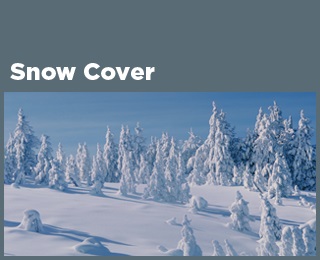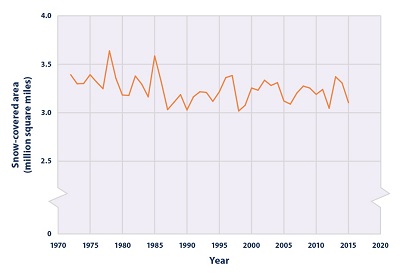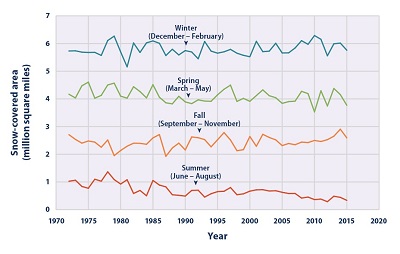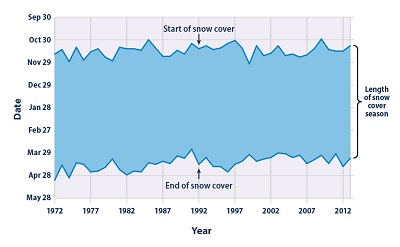|
|
| |
|
|
| |
|
|
|
|
| |
 Climate Change Indicators: Snow
Cover Climate Change Indicators: Snow
Cover
This indicator measures the amount of land in North America
that is covered by snow.
Key Points
When averaged over the entire year, snow covered an average
of 3.24 million square miles of North America during the
period from 1972 to 2015 (see Figure 1).
The extent of snow cover has varied from year to year. The
average area covered by snow has ranged from 3.0 million to
3.6 million square miles, with the minimum value occurring
in 1998 and the maximum in 1978 (see Figure 1).
Between 1972 and 2015, the average extent of North American
snow cover decreased at a rate of about 3,300 square miles
per year. The average area covered by snow during the most
recent decade (2006–2015) was 3.21 million square miles,
which is about 4 percent smaller than the average extent
during the first 10 years of measurement (1972–1981)—a
difference of 122,000 square miles, or approximately an area
the size of New Mexico (see Figure 1).
Decreases in snow cover have largely occurred in spring and
summer, whereas fall and winter snow cover have remained
fairly steady over the time period studied (see Figure 2).
Spring and summer snow cover can have a particularly
important influence on water supplies.
Since 1972, the U.S. snow cover season has become shorter by
nearly two weeks, on average (see Figure 3). By far the
largest change has taken place in the spring, with the last
day of snow shifting earlier by 19 days since 1972. In
contrast, the first date of snow cover in the fall has
remained relatively unchanged. |
|
Background
Snow cover refers to the amount of land covered by snow at
any given time. Naturally, it is influenced by the amount of
precipitation that falls as snow. Air temperature also plays
a role because it determines whether precipitation falls as
snow or rain, and it affects the rate at which snow on the
ground melts. As temperature and precipitation patterns
change, so can the overall area covered by snow.
Snow cover is not just something that is affected by climate
change; it also exerts an influence on climate. Because snow
is white, it absorbs only a small portion of the sunlight
that hits it (10 to 20 percent in the case of fresh snow),
and it reflects the rest back to space. In contrast, darker
surfaces such as bare ground and open water absorb the
majority of the energy they receive and heat up more
quickly. In this way, the overall amount of snow cover
affects patterns of heating and cooling over the Earth’s
surface. More snow means more energy reflects back to space,
resulting in cooling, while less snow cover means more
energy is absorbed at the Earth’s surface, resulting in
warming.
On a more local scale, snow cover is important for many
plants and animals. For example, some plants and animals
rely on a protective blanket of snow to insulate them from
sub-freezing winter temperatures. Humans and ecosystems also
rely on snowmelt to replenish streams and groundwater. Snow
cover also keeps the soil moist, so if the snow melts away
earlier in the spring, the soil may dry out sooner, which
can stress plants and increase the risk of wildfire. |
|
About the Indicator
This indicator tracks the area covered by snow since 1972,
based on maps generated by analyzing satellite images
collected by the National Oceanic and Atmospheric
Administration. Figure 1 was created by analyzing weekly
maps to determine the total extent of snow cover, then
averaging the weekly observations together to get a value
for each year. Figure 2 uses the same method, but with
average snow cover calculated for each season: spring
(defined as March–May), summer (June–August), fall
(September–November), and winter (December–February). These
two figures cover all of North America, not including
Greenland. Figure 3 focuses on the contiguous 48 states plus
Alaska. It shows the average date when snow first starts to
cover the ground in the fall, the average last date of snow
cover in the spring, and the length of time between them.
These snow cover season dates have been averaged over all
parts of the country that regularly receive snow.
Indicator Notes
Although satellite-based snow cover maps are available
starting in the mid-1960s, some of the early years are
missing data from several weeks during the summer, which
would lead to an inaccurate annual average. Thus, the
indicator is restricted to 1972 and later, with all years
having a full set of data.
Data Sources
The data for this indicator were provided by the Rutgers
University Global Snow Lab, which posts data online at:
https://climate.rutgers.edu/snowcover, and the National
Oceanic and Atmospheric Administration’s National
Environmental Satellite, Data, and Information Service,
which collects satellite measurements and compiles maps at:
www.nesdis.noaa.gov.
Technical Documentation
Download related technical information PDF |
|
 Figure
1. Snow-Covered Area in North America, 1972–2015 Figure
1. Snow-Covered Area in North America, 1972–2015
This graph shows the average area covered by snow in a given
calendar year, based on an analysis of weekly maps. The area
is measured in square miles. These data cover all of North
America (not including Greenland).
Data source: Rutgers University Global Snow Lab, 20162 |
 Figure
2. Snow-Covered Area in North America by Season,
1972–2015 Figure
2. Snow-Covered Area in North America by Season,
1972–2015
This graph shows the average area covered by snow during
spring (March–May), summer (June–August), fall
(September–November), and winter (December–February), based
on an analysis of weekly maps. The area is measured in
square miles. These data cover all of North America (not
including Greenland).
Data source: Rutgers University Global Snow Lab, 20163 |
 Figure
3. Snow Cover Season in the United States, 1972–2013 Figure
3. Snow Cover Season in the United States, 1972–2013
This figure shows the timing of each year’s snow cover
season in the contiguous 48 states and Alaska, based on an
average of all parts of the country that receive snow every
year. The shaded band spans from the first date of snow
cover until the last date of snow cover.
Data source: NOAA, 20154 |
|
|
|
EPA Page |
|
This is the
EPA page for this topic. To see if the Trump
administration has changed the EPA page, simply click the
link and compare the information with this page. If you
notice changes were made to the EPA page, please post a
comment. Thanks. |
|
|
|
|
|
|
|
|
|
|
|
|
Additional Climate Change Information |
Climate Change and Carbon Dioxide
(Beginner - Listening,
reading)
A video lesson to
help with your understanding of climate change
and carbon dioxide.
The English is
spoken at 75% of normal speed.
Great English listening and reading practice. |
Carbon Dioxide and Climate Change
(Beginner - Listening,
reading)
A video lesson to
help with your understanding of carbon dioxide
and climate change.
The English is
spoken at 75% of normal speed.
Great English listening and reading practice. |
Environmental Group Warns Earth's Health at Risk
(Beginner - Listening,
reading)
A video lesson to
help with your understanding of climate change.
The English is
spoken at 75% of normal speed.
Great English listening and reading practice.
A report by the World Wildlife Fund looked at thousands of animal populations
and found they have dropped significantly in 40 years. |
Sea Levels Rising at Fastest Rate in 3,000 years
(Beginner - Listening,
reading)
A video lesson to
help with your understanding of climate change.
The English is
spoken at 75% of normal speed.
Great English listening and reading practice.
A group of scientists say sea levels are rising at record rates. Another group
found that January temperatures in the Arctic reached a record high. |
Capturing CO2 Gas Is Not Easy
(Beginner - Listening,
reading)
A video lesson to
help with your understanding of climate change.
The English is
spoken at 75% of normal speed.
Great English listening and reading practice.
Most scientists agree that carbon-dioxide gas is partly to blame for climate
change: rising global temperatures. But capturing the CO2 gas released by power
stations is costly and difficult. |
Growth, Climate Change Threaten African Plants and
Animals
(Beginner - Listening,
reading)
A video lesson to
help with your understanding of climate change.
The English is
spoken at 75% of normal speed.
Great English listening and reading practice.
Researchers believe Africa may lose as much as 30 percent of its animal and
plant species by the end of this century. |
|
|
|
|
Search Fun Easy English |
|
|
|
|
|
|
|
|
|
|
|
|
|
|
|
About
Contact
Copyright
Resources
Site Map |